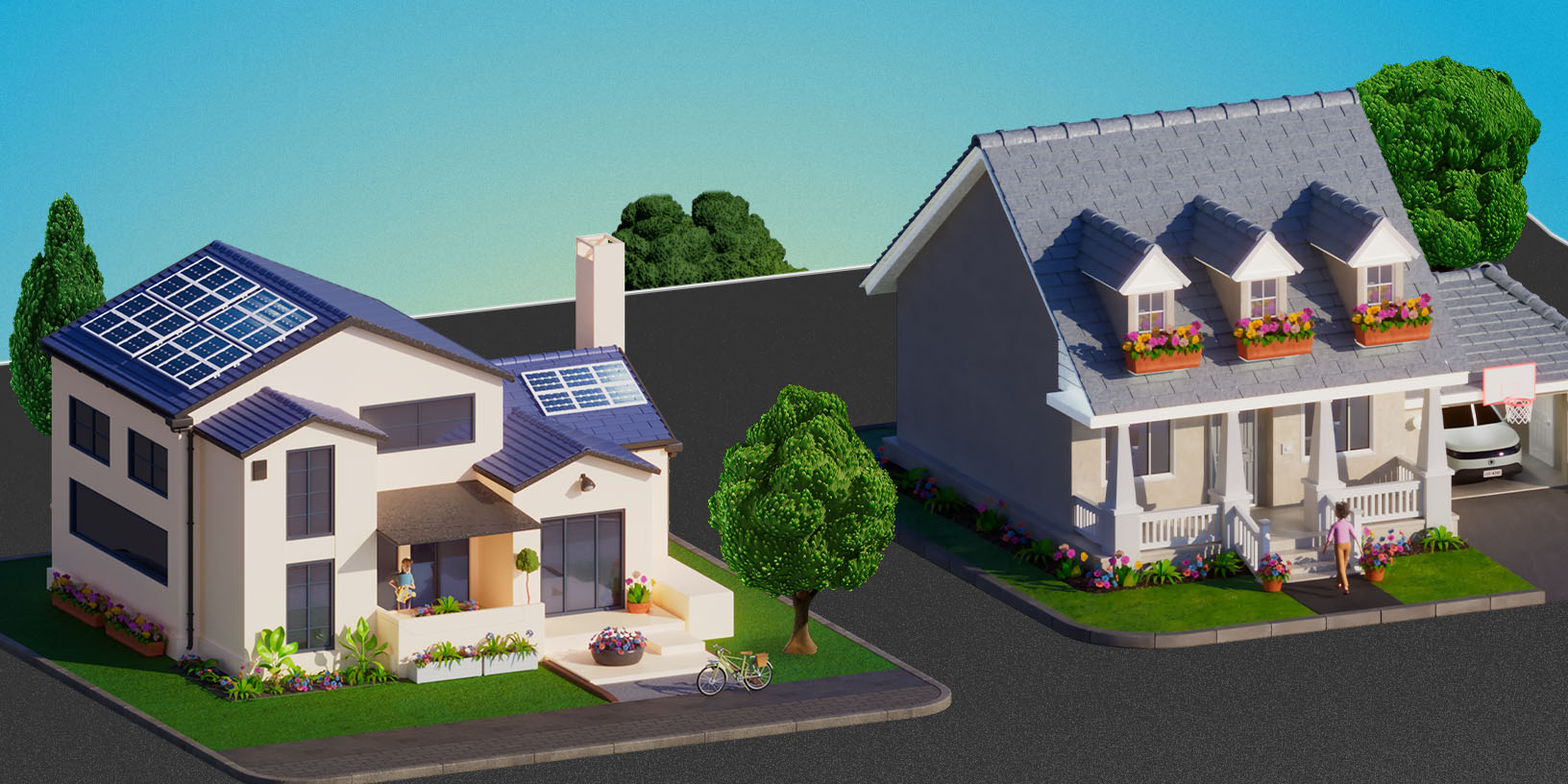Green Mountain Energy's Guide to Going Solar
How Your Household Energy Usage Plays a Role in Going Solar

Understanding your own energy usage patterns and the factors that influence your electricity bill each month is important for any consumer on any electricity plan – be it conventional or solar.
In this article, we’re going to unpack how to calculate your energy usage and how an understanding of your energy usage can help you make informed decisions if you’re looking into solar electricity through a solar plan or a solar panel installation.
Take Control of Your Energy Costs: How to Read Your Bill
Whether you’re using solar power through your own panels, a solar energy plan or traditional energy sources, your electricity bill is your road map.
Everything you need to know is on that piece of paper; let’s dive into the details of some common energy bill components:
Common Energy Bill Components
Whether or not these energy bill components appear on your bill will vary, and your utility provider may use different terms – but these are the basics that will appear on most energy bills.
1. Account Information:
Provides an overview of your account status, including previous balance, any previous payments and the current amount due.
2. Billing Summary
Indicates the specific dates for the billing cycle. This will show the start and end dates for the energy usage being billed for.
3. Usage Summary:
Displays the total energy consumption for the billing period, usually measured in kilowatt-hours (kWh).
This section compares your current energy usage to previous months or the same month in the previous year, which gives you insight into how your consumption patterns may have changed over time.
4. Rate Plan Details:
Specify the type of electricity plan you are on (fixed, variable or time-of-use) and the prices charged per kWh.
5. Detail of Charges and Credits:
Itemizes all charges, which can include the following:
Energy Charges: Costs based on the amount of electricity used.
Delivery Charges: Fees for the delivery of energy to your home.
Taxes and Fees: Local, state and federal taxes – as well as any relevant regulatory fees.
6. Peak Usage Information:
This section highlights times when your energy usage was highest, which can be critical for time-of-use plans where rates vary by time of day and overall, for understanding your usage habits. Note that this type of data may not be available with all providers or plans, so be sure to check the details of your own plan.
7. Environmental Impact:
If you're a Green Mountain Energy customer, your bill may also feature a snapshot of your environmental impact to date. particularly if you're using solar energy. You'll see an informative breakdown of how many pounds of CO2 emissions you've helped avoid and the equivalent number of trees saved.
8. Provider Messages:
You may receive important alerts or messages from your utility provider, such as price changes, energy-saving tips or upcoming infrastructure maintenance.
9. Payment Details:
Details on how to pay your bill, including online payment portals (like the Green Mountain Energy app) or instructions on how to set up auto-pay.
Want additional information? Green Mountain Energy provides additional details on how to read your bill here.
Energy Efficiency Made Easy: Understand and Adjust Your Usage Patterns
Knowing when you use the most energy (and what uses the most energy) in your home can help you adjust your habits to save money and reduce your overall energy consumption. Another way to gain more insight into your energy usage habits is to take a look at your daily life and household setup.
Think about your appliances and general daily routine. Are your appliances a little out of date or in need of maintenance? Do you do your laundry every day or just once per week? Small changes can play a big role in the amount of energy you consume on a daily basis.
Winter and daylight savings can cause significant variations in how much electricity you consume in a day – if it’s getting dark at 4 p.m., it’s natural to turn the lights on earlier in the day.
If you’re a Green Mountain Energy customer, log into My Account to see daily and weekly breakdowns of your solar electricity usage. Other utility companies – whether you’re on a solar energy plan or a traditional energy plan – will usually have a similar breakdown when you log into your account.
Factors That Influence Energy Usage

Household size and lifestyle
Growing families, roommates, working from home and the overall size of your residence are all huge factors in your electricity bill each month.
Energy-efficient appliances and electronics
Energy-efficient appliances and lighting will also play a critical role in your bill each month.
Look for ENERGY STAR-certified products when you go shopping for new light bulbs or a new stove – they typically use 10 to 50% less energy than their standard counterparts.
In that vein, smart home technology, like smart thermostats and smart lighting systems, can help you monitor and control your energy use more effectively.
Insulation and home construction
A weatherproof, well-insulated home that is built to be energy-efficient can reduce the amount of energy required for heating and cooling.
Your windows are instrumental in managing your home's temperature. Ensure your window hardware is in good condition and opt for ENERGY STAR-certified windows with double or triple glazing to minimize heat loss/gain.
Use Apps for Tracking Energy Consumption
In addition to reading and understanding your monthly energy bill and daily habits, you can also track your average energy usage with apps.
If you're a customer with us, you can use our Green Mountain Energy app, or you can use third-party apps like Energy Tracker to monitor your energy usage.
How to Pick the Best Energy Plan for You
Depending on where you live, there are different types of energy plans available, including fixed and variable plans. Each has its own benefits and drawbacks. Fixed-rate plans are just that: a set rate each month regardless of the time of year. Variable plans include a base charge per kilowatt hour that changes based on the market rate at the time.
Green energy plans can help you reduce your carbon footprint, support clean energy demand and generation, and help the planet while supporting your green lifestyle.
Choosing the best energy plan means considering several lifestyle factors: your current housing situation, whether you’re moving soon, if your family could be expanding, if you rent or own, or if you own an EV. Depending on these factors, it may even look like a bigger decision between solar plans vs. solar panel installations.
Start Your Solar Energy Journey with Green Mountain Energy
Understanding your energy usage is crucial for making informed decisions about your electricity consumption, whether you're using traditional energy sources or considering solar options. If you’re considering a switch to solar, this will help inform how much solar energy you need to generate or subscribe to.
By knowing your average usage, you can better determine the size of the solar system required or how much of your energy needs can be offset by a community solar plan. This ensures you maximize both savings and environmental benefits while tailoring your energy plan to fit your lifestyle.
Green Mountain Energy offers a range of solutions to help you start your clean energy journey, whether through solar energy plans, solar panel installations or other green electricity options.
Take a big step for the planet with a renewable energy plan.
Enter your ZIP code to get started.
March 08, 2025
Not ready to install solar panels? No problem. Learn about renewable energy plans that allow you to power your home with 100% clean energy without the need for rooftop panels. Compare plans and find the one that best suits your needs.
March 06, 2025
Ready to install solar panels? This article walks you through the process from assessing your home’s suitability to finding the right solar panel installers and electricity provider. It also explains financial incentives and what to expect from the installation process.
March 05, 2025
Not every home is suitable for solar panels. Learn how to evaluate your roof’s orientation, shading, and condition to determine if your home is a good candidate for solar panels and how they may impact your property value.


